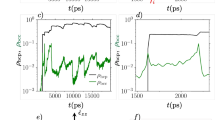Abstract.
We analyze a large-scale molecular dynamics simulation of work hardening in a model system of a ductile solid. With tensile loading, we observe emission of thousands of dislocations from two sharp cracks. The dislocations interact in a complex way, revealing three fundamental mechanisms of work-hardening in this ductile material. These are (1) dislocation cutting processes, jog formation and generation of trails of point defects; (2) activation of secondary slip systems by Frank-Read and cross-slip mechanisms; and (3) formation of sessile dislocations such as Lomer-Cottrell locks. We report the discovery of a new class of point defects referred to as trail of partial point defects, which could play an important role in situations when partial dislocations dominate plasticity. Another important result of the present work is the rediscovery of the Fleischer-mechanism of cross-slip of partial dislocations that was theoretically proposed more than 50 years ago, and is now, for the first time, confirmed by atomistic simulation. On the typical time scale of molecular dynamics simulations, the dislocations self-organize into a complex sessile defect topology. Our analysis illustrates numerous mechanisms formerly only conjectured in textbooks and observed indirectly in experiments. It is the first time that such a rich set of fundamental phenomena have been revealed in a single computer simulation, and its dynamical evolution has been studied. The present study exemplifies the simulation and analysis of the complex nonlinear dynamics of a many-particle system during failure using ultra-large scale computing.
Similar content being viewed by others
References
Hirth, J.P., Lothe, J. : Theory of Dislocations. Wiley-Interscience, 1982
Hull, D., Bacon, D.J.: Introduction to Dislocations. Butterworth Heinemann, 2002
Courtney, T.H.: Mechanical behavior of materials. McGraw-Hill, 1990
Allen, M.P., Tildesley, D.J.: Computer Simulation of Liquids. Oxford University Press, 1989
Abraham, F.F., Walkup, R., Gao, H. et al.: Simulating materials failure by using up to one billion atoms and the world’s fastest computer: Work-hardening. P. Natl. Acad. Sci. USA, 99(9): 5783–5787 (2002)
Gumbsch, P., Gao, H.: Dislocations faster than the speed of sound. Science, 283: 965–968 (1999)
Buehler, M.J., Abraham, F.F., Gao, H.: Hyperelasticity governs dynamic fracture at a critical length scale. Nature, 426: 141–146 (2003)
Wolf, D., Yamakov, V., Phillpot, S.R. et al.: Deformation mechanism and inverse Hall-Petch behavior in nanocrystalline materials. Z. Metallk., 94: 1052–1061 (2003)
Yamakov, V., Wolf, D., Phillpot, S.R., Mukherjee, A.K. et al.: Dislocation processes in the deformation of nanocrystalline aluminium by MD simulation. Nature Materials, 1: 1–4 (2002)
van Swygenhoven, H., Derlet, P.M., Hasnaoui, A.: Atomic mechanism for dislocation emission from nanosized grain boundaries. Phys. Rev. B, 66: 024101 (2002)
Farkas, D., van Swygenhoven, H., Derlet, P.: Intergranular fracture in nanocrystalline metals. Phys. Rev. B, 66: 060101 (2002)
Derlet, P.M., Hasnaoui, A., van Swygenhoven, H.: Atomistic simulations as guidance to experiments. Scripta Mater., 49: 629–635 (2003)
Schiotz, J., Leffers, T., Singh, B.N.: Dislocation nucleation and vacancy formation during high-speed deformation of fcc metals. Phil. Mag. Lett., 81: 301–309 (2001)
Jacobsen, K.W., Schiotz, J.: Computational materials science - nanoscale plasticity. Nature Materials, 1: 15–16 (2002)
Rhee, M., Zbib, H.M., Hirth, J.P. et al.: Models for long-/short-range interactions and cross slip in 3D dislocation simulation of bcc single crystals. Modeling Simul. Mater. Sci. Eng., 6(4): 467–492 (1998)
Wen, M., Lin, D.L.: Atomistic process of dislocation cross-slip in Ni3Al. Scripta Mater., 36: 265–268 (1997)
Zhou, S.J., Preston, D.L., Louchet, F.: Investigation of vacancy formation by a jogged dissociated dislocation with large-scale molecular dynamics and dislocation energetics. Acta Mater., 47: 2695–2703 (1999)
Li, M., Zhou, S.J.: Investigation of jog motion in gamma-TiAl via molecular dynamics. Phil. Mag. Lett., 79: 773–784 (1999)
Li, M., Chu, W.Y., Qian, C.F. et al.: Molecular dynamics simulation of dislocation intersections in aluminum. Mat. Sci. Eng. A, 363: 234–241 ( 2003)
Zhou, S.J., Preston, D.L., Lomdahl, P.S. et al.: Large-scale molecular-dynamics simulations of dislocation interactions in copper. Science, 279: 1525–1527 (1998)
Bulatov, V., Abraham, F.F., Kubin, L. et al.: Connecting atomistic and mesoscale simulations of crystal plasticity. Nature, 391: 669–672 (1998)
Schiotz, J., Jacobsen, K.W.: A maximum in the strength of nanocrystalline copper. Science, 301: 1357–1359 (2003)
Yamakov, V., Wolf, D., Phillpot, S.R. et al.: Dislocation-dislocation and dislocation-twin reactions in nanocrystalline Al by molecular dynamics simulation. Acta Mat., 51: 4135–4147 (2003)
Yamakov, V., Wolf, D., Phillpot, S.R. et al.: Deformation-mechanism map for nanocrystalline metals by molecular dynamics simulation. Nature Materials, 3: 43–47 (2004)
Kelchner, C., Plimpton, S.J., Hamilton, J.C.: Dislocation nucleation and defect structure during surface-indentation. Phys. Rev. B, 58: 11085–11088 (1998)
Mott, N.F.: The work hardening of metals. Trans. Met. Soc. AIME, 218: 962 (1960)
Krause-Rehberg, R., Brohl, M., Leipner, H. et al.: Defects in plastically deformed semiconductors studied by positron annihilation: Silicon and germanium. Phys. Rev. B, 47: 13266–13276 (1993)
Rempel, A.A., Nazarova, S.Z., Gusev, A.I.: Intrinsic defects in palladium after severe plastic deformation. Phys. Stat. Sol., 181: R16 (2000)
Marian, J., Cai, W., Bulatov, V.V.: Dynamic transitions from smooth to rough to twinning in dislocation motion. Nature Materials, 3: 158–163 (2004)
Fleischer, R.L.: Cross slip of extended dislocations. Acta Metall., 7: 134–135 (1959)
Qi, Y., Strachan, A., Cagin, T., Goddard, W.A.: Large-scale atomistic simulations of screw dislocation structure, annihilation and cross-slip in FCC Ni. Mat. Sci. Eng.A, 309–310, 156–159 (2001)
Vegge, T., Jacobsen, W.: Atomistic simulations of jog migration on extended screw dislocations. Mat. Sci. Eng. A, 319–321 , 119–123 (2001)
Vegge, T., Jacobsen, W.: Atomistic simulations of dislocation processes in copper. J. Phys. Condens. Matt., 14: 2929–2956 (2002)
Shenoy, V.B., Kukta, R.V., Phillips, R.: Quasicontinuum models of interfacial structure and deformation. Phys. Rev. Lett., 84: 1491–1494 (2000)
Hirsch, P.B., Warrington, D.H.: The flow stress of aluminium and copper at high temperatures. Phil. Mag., 6: 735 (1961)
Author information
Authors and Affiliations
Corresponding author
Rights and permissions
About this article
Cite this article
Buehler, M., Hartmaier, A., Gao, H. et al. The dynamical complexity of work-hardening: a large-scale molecular dynamics simulation. ACTA MECH SINICA 21, 103–111 (2005). https://doi.org/10.1007/s10409-005-0019-9
Received:
Accepted:
Published:
Issue Date:
DOI: https://doi.org/10.1007/s10409-005-0019-9




